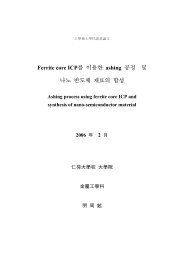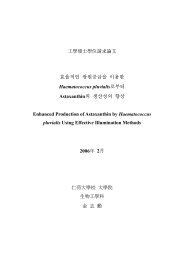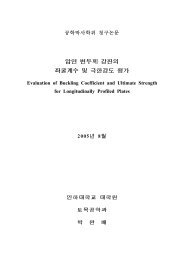저작자표시-비영리-변경금지 2.0 대한민국 이용자는 아래의 조건을 ...
저작자표시-비영리-변경금지 2.0 대한민국 이용자는 아래의 조건을 ...
저작자표시-비영리-변경금지 2.0 대한민국 이용자는 아래의 조건을 ...
Create successful ePaper yourself
Turn your PDF publications into a flip-book with our unique Google optimized e-Paper software.
efficiency of different particles, suggesting that CNFs exhibited an<br />
excellent nucleation effect due to its food dispersion in the polymer<br />
matrix, as well as the favorable wettability and surface curvature in that<br />
foaming process. On the contrary, using a chemical blowing agent,<br />
Guan et al. manufactured the poly(propylene carbonate) (PPC) foams<br />
with a blowing ratio of 16. The decomposition behavior of the blowing<br />
agent was investigated, and the effect of blowing agent content and<br />
[20-24, 36]<br />
the foaming condition on the foaming of PPC studied.<br />
Recently, synthetic petroleum-based polymers have caused serious<br />
environmental problems due to their limited degradation. For this<br />
reason, biodegradable polymers have drawn substantial attention<br />
owing to environmental concerns. Among these polymers,<br />
biodegradable aliphatic polyester types, i.e., poly(ε-caprolactone)<br />
(PCL), poly(lactic acid) (PLA), poly(3-hydroxybutyrae) (PHB) and<br />
poly(butylene succinate) (PBS), have currently been the focus of much<br />
attention. [25-30] However, they lack price competitiveness and a<br />
practically acceptable level of processability, and their usage is due to<br />
relatively poor physical properties in particular. Therefore, the<br />
incorporation of nanoscale fillers into biodegradable aliphatic<br />
polyesters has been studied by many research groups with the aim of<br />
4







